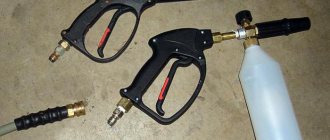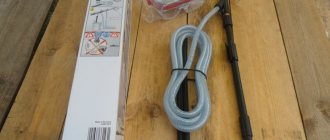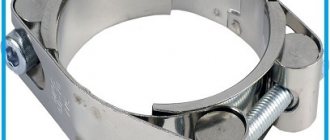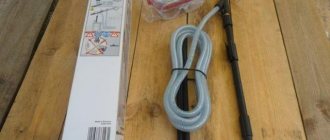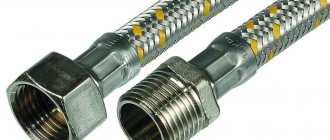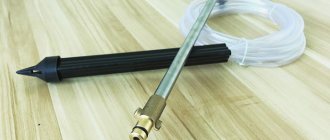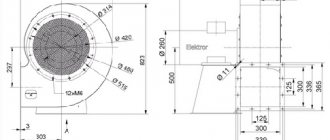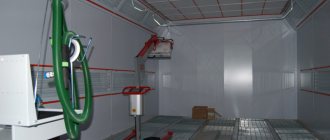How to crimp a high pressure hose with your own hands
High pressure hoses are used in pneumatic and hydraulic structures.
In the automotive industry, they are widely used in steering systems. Thanks to the built-in hydraulic booster, the driver does not have to apply significant load on the steering wheel when turning. However, under certain operating conditions, various deformations of tubes or hoses are possible. Subsequently, this leads to unstable operation of the unit, which can be corrected by repairing the power steering high-pressure hoses with your own hands or with the help of service station specialists.
Hydraulic operation
Hoses, which are often called high-pressure hoses, are flexible pipelines whose main task is pumping working fluids. The transported material is specially prepared motor oils or working fluids based on mineral oils, aqueous solutions of emulsols, glycol, and greases.
Without high-quality flexible hoses that can withstand the required pressure and an extensive pipeline system, it is difficult to imagine the operation of a hydraulic booster. In addition to the direct duty related to pumping working fluid, such hoses act as dampers (compensators), increasing the operational period of connecting elements, fittings, fittings and the system as a whole.
Vibration absorption by flexible elements contributes to obtaining such results. The negative side of the phenomenon is that periodic replacement or repair of power steering hoses in worn areas is required. After all, all abrasions or kinks soon lead to the tube leaking .
Structural features of power steering hoses
In addition to working under high pressure, the power steering hose must have reduced susceptibility to the working fluids used. Thanks to this, its inner surface is made on the basis of oil- and gasoline-resistant synthetic rubber.
The outer surface is protected by layers of wear-resistant rubber. Under certain circumstances, this layer plays the role of thermal protection. It may have the following surfaces:
- corrugated;
- polymer;
- metal.
The outer and inner layers are separated by a metal braid. This gives the entire structure the required operational strength and acceptable rigidity. Wire layers alternate with rubberized elements.
It is customary to distinguish the following types of hoses:
- Winding . During the manufacture of this product, turns of wire are braided evenly around the entire perimeter.
- Braided . Each turn covers the sleeve at a certain angle to the common axis in such a way that it intersects with the turns of the previous layers. This technology increases the strength of the structure and can operate at higher pressures than the previous type.
The frame for the sleeve in some models is textile. The geometric and physico-chemical parameters of wire and rubber are standardized for various applications.
Suspected damage
During operation, motorists may encounter different types of hydraulic damage, after which repair of the power steering hoses is necessary. The following points can be noted:
- Manufacturer defect . This feature is typical for insufficiently known hydraulic equipment manufacturing companies. Failure is characterized by poor-quality crimping of the joint of a sleeve or fitting. This happens when the equipment is undebugged or incorrectly configured.
- Operational output . Damage occurs due to wear and tear during operation of the mechanism. The main problems are cord breaks, cuts and frayed areas. This often occurs due to hose sagging due to incorrectly selected length.
- Structural inconsistencies . Failure occurs due to the installation of equipment that does not meet the specifications specified by the automaker. In such situations, a wire rupture or fittings may break due to a discrepancy between the pressure in the system and the permissible value for the hose.
- Disagreement in temperature or chemical characteristics . Damage to the structure can occur during operation at an ambient temperature for which such rubber was not designed, as well as during the use of aggressive chemicals in the structure of the working fluid.
Damage to power steering hoses
The manufacturer indicates all characteristics and permissible operating parameters for each hose in the instructions for use.
Hydraulic malfunctions with which further operation of the vehicle is not recommended:
- fittings are significantly damaged by corrosion processes;
- significant fracture of the sleeve;
- significant abrasion of the outer part of the hose;
- the presence of complete or partial blockage inside the sleeves;
- lack of sealing of connections;
- failure of the fitting from the landing diameter;
- liquid leakage at joints;
- deformation or damage to the inner surface from high pressure or excess temperature.
Troubleshooting power steering hoses
Damage to the hose in most cases occurs due to frequent turning of the steering wheel with great force. Wear occurs at the hose connected to the limit valve.
When installing and repairing power steering hoses, it is necessary to take into account that the permissible pressure in the system can vary depending on car models in the range of 80...130 kgf/cm 2.
Such significant performance indicators do not allow the use of any types of clamps during repairs. You need to choose the most appropriate option:
- Complete replacement of the sleeve.
- Partial replacement of a deformed or worn area with installation of fittings on a new hose.
Replacement and installation of a new hose is carried out according to the following points:
- the front axle must be raised using a lift or jack;
- the steering wheel is turned as far as possible to the left;
- a tube is put on the end of the medical syringe to pump out the remaining working fluid from the tank;
- after pumping, the hose must be disconnected and the hydraulic holes must be plugged;
- a new hose with acceptable operating characteristics is selected so that the operational characteristics of the unit do not change;
- a new hose is installed in place of the old hose, after which the working fluid is poured into the system.
If the work is carried out correctly, the functionality of the hydraulics is completely restored.
Crimping high-pressure hoses with your own hands - Metalworker's Guide
High pressure hoses are used in pneumatic and hydraulic structures. In the automotive industry, they are widely used in steering systems. Thanks to the built-in hydraulic booster, the driver does not have to apply significant load on the steering wheel when turning.
However, under certain operating conditions, various deformations of tubes or hoses are possible. Subsequently, this leads to unstable operation of the unit, which can be corrected by repairing the power steering high-pressure hoses with your own hands or with the help of service station specialists.
Carrying out repairs
Based on the nature of possible damage, it can be assumed that the most common repair of power steering hoses involves putting the fittings in order or replacing individual parts of the hose. To carry out the replacement, crimping with couplings will be necessary.
Tools for DIY repairs
The work algorithm may be as follows:
- The damaged hose must be disconnected from the system.
- The new hose will need to be the same length so as not to create unnecessary sagging. The measurement is carried out from nipple to nipple. At the same time, we select a hose that satisfies all geometric data and pressure parameters. The markings indicated on the outside by the manufacturer will help with this. The internal diameter will also be indicated there.
- When repairing a high-pressure hose, the ends are stripped both outside and inside to the metal braid. The procedure is carried out faster using debarking machines.
- Fittings are selected according to geometric parameters and technological thread data. Measurements are easy to take using a caliper and thread gauge. Domestic and foreign fittings may differ from each other according to several criteria, so it is better to take measurements yourself.
- We crimp the fittings using crimping equipment, using suitable removable jaws in each case.
- Using a control probe, we determine the quality of the work performed. At specialized factories, this operation is carried out using special industrial stands.
Equipment for crimping high pressure hoses
For the manufacture of high-pressure hoses, a special type of equipment is used - crimping machines. With their help, a reliable connection of the components of the hose design is formed.
Operating principle of crimping machines
The general operating principle of the machine is based on pressing fittings of various configurations onto the end parts of the hose. Performing this work requires accurate calculation of the optimal degree of pressure while maintaining the integrity of the high-pressure hose.
Cleaning and testing of high pressure hoses
For those who want to be confident in the quality of manufactured hoses, we offer a unique additional service - testing of finished products. The special Uniflex test bench we use allows us not only to check the load under the most severe conditions, but also to treat the hose hose with a water-oil mixture, which has an anti-corrosion effect.
Cleaning of hose hoses is also carried out using German Uniflex equipment. Flushing of the high pressure hose is carried out both from the inside and from the outside. After washing, the sleeves are completely cleaned of microdust, burrs, etc.
Source
How to connect a high pressure hose with your own hands?
High pressure hoses are used in pneumatic and hydraulic structures. In the automotive industry, they are widely used in steering systems. Thanks to the built-in hydraulic booster, the driver does not have to apply significant load on the steering wheel when turning.
However, under certain operating conditions, various deformations of tubes or hoses are possible. Subsequently, this leads to unstable operation of the unit, which can be corrected by repairing the power steering high-pressure hoses with your own hands or with the help of service station specialists.
We tell you where and how to repair a Karcher hose!
The Korbit tourist club has an equipment base. There is a well and a Karcher pressure washer. For three years this entire system worked without failure. And so, the Karcher hose broke... Many questions immediately arose. Where can I buy a new hose? Where to go if you need Karcher urgently?
We found out everything and are sharing our experience! Firstly, the Karcher hose is a high pressure hose and can be repaired. Secondly, you can repair Karcher high-pressure hoses yourself, or you can do it in a specialized organization.
DIY Karcher hose repair
The technology for repairing a Karcher hose with your own hands is very simple. First, cut the hose along the edges of the tear. Then we make even cuts - either with special scissors, or a machine, or a cutting tool.
After that, we go to a special store to get a fitting (a connecting tube along the inner diameter of the hose) and special power clamps. Ideally, place a pair of clamps on each side. Attention, simple clamps will not work!
This DIY hose repair has its drawbacks. If the hose is used in the washing area, the repair unit (clamps) will constantly cling to something, which is inconvenient.
Another minus. If you don’t have a fitting and a power clamp in your garage (in your warehouse), you still have to waste time searching for and purchasing a fitting of the required diameter and clamps.
But there are also advantages. Such repairs of Karcher high-pressure hoses will not be expensive. Especially if you need to extend the hose or make several repair connections.
Repair of Karcher hose in a specialized organization
If you have little free time, you should turn to professionals. Pros. The Karcher hose will be repaired on site in 10 minutes. They are repaired carefully, the repair unit will not interfere with work with the sink. Repaired using professional equipment and reliably.
Minuses. The cost of repair is 500-800 rubles for each unit. That is, with the market price of a non-original, but acceptable quality Karcher hose at 2000-2500 rubles (autumn 2018), it makes sense to make repairs if you have a relatively new hose and no more than 2 damages. In other cases, it is worth thinking about a new hose.
Subscribe to our news! Don't miss cool events and important information!
- click here -
We have compiled a list of organizations in large cities of the Central Federal District where you can repair a Karcher hose:
- Belgorod, st. Dzgoeva, 6, tel.
- Bryansk
- Vladimir
- Voronezh, st. Dorozhnaya 50, tel. 8 (473)2582296
- Ivanovo
- Kaluga
- Kostroma
- Kursk
- Lipetsk, Voronezhskoe highway, building 35, tel. 8 (4742) 711-411
- Eagle
- Ryazan
- Smolensk
- Tambov, st. Urozhaynaya, 1A, tel. 8 (4752) 569320
- Tver
- Tula
- Yaroslavl
If your city is not listed, try clicking here.
Reasons for repairing Karcher high pressure hoses
At least in a nutshell, we need to talk about the reasons for the repair. In our case, the reason is this: the sink itself “shudders” when started. The hose coming from the sink gradually rubbed against a sharp corner.
But there may be other reasons - poor-quality hose material, the working pressure of the hose does not correspond to the washing pressure, the hose is outdated, and others. Of course, all these reasons need to be eliminated.
That's all! Keep your tools in working order and continue to enjoy working with your hands! Have a good day!
Fittings for hoses for various purposes: what they are and how to choose
Stationary irrigation lines for summer cottages made of metal are extended with pipes of a common diameter by welding. To increase the length of flexible irrigation systems, hose fittings are needed to prevent squeezing and depressurization.
Leaks occur when connecting two sections using a primitive method - a metal tube and clamps.
And high-quality connecting fittings will ensure reliable connection of the hose sections with the pump, but it is important to understand the classification and purpose of each connecting element.
Connecting elements for hoses vary in purpose, material of manufacture and technical characteristics
Types of hose connectors
Integral elements of a flexible “external” water conduit are made from different materials:
- metal;
- polymer;
- composite.
In a dry summer, one of the daily concerns of a summer resident may include “sprinkling” remote corners of the garden. This work will be facilitated by a well-organized irrigation system, which uses not only fittings for connecting hoses, but also other elements of high-quality irrigation:
- flanges;
- fittings;
- adapters;
- adapters;
- turn signals (knee);
- universal connectors;
- connectors with different diameters on both sides;
- tees and crosses;
- couplings and clamps (as auxiliary equipment).
In addition to them, the following are in great demand as options for adjusting the watering jet:
- taps;
- filters;
- plugs;
- valves;
- sprinklers;
- sprinklers;
- “pistols” (other attachments).
You can regulate the pressure and flow of water when using a watering hose using special spray nozzles
Some of the nozzles inside have a rotating module - for better watering. Among the connecting devices, not only options for irrigation are offered, but also elements of other functionality:
- fittings for joining gas hoses;
- nipples for washing machines;
- connectors for hoses and high-pressure hoses (HPR);
- hydraulic fittings.
It is advisable to use connectors not only to extend the hose, but also when its integrity is compromised - the appearance of “fountains” or “unscheduled drip irrigation”.
Fittings with options that allow you to temporarily shut off the water without turning it off at the main valve are very convenient.
The most popular are relatively inexpensive and high-quality Gardena and Hozelock connectors.
Hydraulic fittings for high pressure hoses
High-quality elements for connecting high-pressure hoses and hoses are produced by domestic and foreign companies. Their range is regularly updated, but the main list of items remains virtually unchanged, but there are minor differences:
- in terms of reliability and quality of articulation;
- in combination of diameters of adapters;
- in additional options.
When working with high-pressure hoses, you should choose high-reliability fittings
Afterword
But in the end, all this torment was not worth it. It’s better to contact the service center and replace the old, broken spare part with a new one.
But if time and money are running out, then you can do like me. You can save money and buy separately only those spare parts that you need, and leave those suitable for use.
Of course, in salons, masters will achieve better results than self-taught drivers. But if hands are not hooks, then why not try?
I hope I helped you, my dear readers. Happy travels!
Do-it-yourself hose crimping machine - Metals, equipment, instructions
To manufacture hose hoses, TsPK LLC placed Finn-Power equipment in its warehouse in Moscow, and we also use Parker components.
The high pressure hose is an indispensable and one of the most important parts of the production process. It transports gases and liquids. But installation of high pressure hoses requires special equipment for reliable fastening of hoses and their strong connection.
Lines for the production of high-pressure hoses today need to be equipped with special crimping equipment. Machines and presses for crimping high-pressure hoses are available in various types and sizes and can be used both in industrial conditions and for urgent repairs anywhere (mobile presses).
Types of hose crimps
Pressure testing of high-pressure hoses is carried out using specialized equipment. The technological process is quite labor-intensive and requires care and precision. Today, mainly two methods are used for crimping:
- 1. European (longitudinal). This method is also applicable when crimping braided hose hoses. The essence of the method is as follows: the internal coupling is equipped with ring teeth, which are inserted into the sleeve braid, ensuring a reliable connection. When crimping two types of hoses - 1SN and 2SN - the outer thin layer of rubber is not removed. This allows you to make the connection even tighter.
- 2. Cross crimp. This method is considered classic and is used most often. Used in crimping high-pressure braided hoses. This process uses a tubular coupling. The process is as follows: the top layer of rubber is removed along the entire length, which holds the sleeve from the inside with transverse protrusions. The coupling is pressed tightly against the sleeve and provides fastening.
Traditional crimping is transverse. Longitudinal is most often used for crimping hose hoses with metal braiding of domestic production, produced in accordance with GOST 6286-73. Such hoses are the most economical and reliable in operation.
In hydraulic systems with high pressure, longitudinal crimping methods are mainly used. The sharp teeth on the coupling cut firmly into the metal braid, allowing you to avoid scraping off the top rubber layer.
The connection is sealed due to high pressure compressing the sleeve on the nipple.
Crimping equipment can be divided into types depending on the scope of application:
- The service press is most often used in workshops and small-scale or even single-piece production;
- a mobile press is in demand for urgent repairs, mines and replacement of high pressure hoses directly on site;
- an industrial press is used in large-scale production.
Features of the machine for the manufacture of hose hoses
The hose crimping press is part of the production line. Today on the market there are both small mobile machines and stationary ones for industry. When choosing a machine, it is necessary to take into account the initial parameters of working with the equipment: the type and diameter of the hose, the maximum size of fittings, the type and performance of the machine.
The scope of use of crimping machines is quite large:
- · production of hydraulic hoses;
- · production of auto parts;
- · production of construction equipment;
- · production of sea and railway transport;
- · production of wire, hoses, pipes and pipelines, cables.
The crimping machine has the following features:
- · works from several sources: battery, compressed air or manually;
- · crimping accuracy is always at its best;
- · the design of the machine is convenient and ergonomic, it is easy to operate;
- · quick pressure testing of hose hoses is possible due to the system for quick replacement of cams;
You can use the machine in production conditions and on site.
Selecting a crimping machine
The reliability of fastening of sleeves and hoses depends on the quality and performance characteristics of the equipment. When choosing, pay attention to the details and characteristics of machines and presses:
- 1. Crimping speed. This parameter is especially important in production. Machines with high crimping speeds are used in multi-batch production and various conveyors. In standard press models, the speed ranges from 300–2500 crimps per hour.
- 2. Mobility. In industrial conditions, mainly stationary powerful machines are installed. In the field, for urgent installation and repair, mobile portable presses will be required.
- 3. Crimping force. Varies between 3500-12000 kN.
- 4. Working diameter. The maximum permissible opening of the crimping jaws in millimeters shows the permissible size of the hose that can be crimped.
High-pressure hoses are used today both in large enterprises and in small workshops. Crimping of the hose may be required at any time. A high-quality crimping machine is a guarantee of connection reliability, long service life and strength of the connection point.
We manufacture hose hoses of any complexity and sizes up to 2.5 inches. with fittings made of galvanized and stainless steel, as well as polymer protection (plastic spiral).
Contact us by phone +7 (495) 247-87-27. We are located at: 115230, Moscow, Elektrolitny proezd, 3, 5 minutes from the Nagornaya metro station.
Manufacturing and repairs are possible in front of you and in the shortest possible time!
Business in the production of high-pressure hoses (HHP) (November 2018) - how to open from scratch, examples and a ready-made plan with calculations for beginners
Train your brain with pleasure
Start developing
High pressure hoses are a pipeline through which any gas or liquid can be distilled. They are used both in everyday life and for industrial purposes. Of course, the characteristics of these products, depending on the purpose, are different. These products also exist on the market from manufacturers from Europe and the CIS countries. Today we will look at how to set up the production of high-quality high-pressure hoses.
- What equipment to choose for the manufacture of high pressure hoses?
- RVD production technology
- Franchise business
- Step-by-step plan for starting a business
- How much can you earn
- How much money do you need to start a business?
- Which OKVED code must be specified for the production of high-pressure hoses?
- What documents are needed to open
- Which taxation system to choose for the production of high-pressure hoses
- Do I need permission to open?
This product requires certain knowledge of the technological process. It is also impossible to organize a production workshop without special equipment. It comes in different capacities and differs in other characteristics. You need to study them before purchasing. It would also be a good idea to find out reviews from industrialists who are already working on it.
What equipment to choose for the manufacture of high pressure hoses?
You can buy equipment for the production of hose hoses in the form of a finished line or each machine separately. The standard kit looks something like this:
| Machine name | Price, thousand rubles |
| Crimping press or crimping device | 200,00 |
| Cutting machine | 80,00 |
| Apparatus for stripping rubber inside and on the surface of hoses | 60,00 |
| Marking machine | 50,00 |
Additional equipment (rolls, frames) will cost another 150 thousand rubles. The prices in the table are the minimum prices. This price segment of equipment will provide an opportunity to open a small production facility.
This is enough to start a business, since it is very important to determine the channels for future sales of products.
After establishing strong partnerships with customers, you can think about increasing production capacity.
To make a high-pressure hose you will need the following equipment:
| 1 | Crimping machine or crimping press. |
| 2 | A device for removing the upper and inner layers of rubber from high-pressure hoses. |
| 3 | Equipment for marking. |
| 4 | Roll for unwinding coils. |
| 5 | Racks for presses. |
| 6 | Storage for a set of jaws. |
The technological process can be divided into several stages:
- preparatory work with material and equipment setup;
- crimping operation;
- quality control and testing of finished products.
High-pressure hoses are distinguished by the type of metal coating. They can be made by braiding or winding. I also use different materials for this process.
Advice on choosing a machine
Manual crimper
Industrial or repair equipment has certain technical characteristics. They are the main selection criterion. Therefore, it is first necessary to study the parameters of the finished product and select a crimping machine that would correspond to them.
Basic selection options:
- crimping force, tons;
- maximum and minimum diameter of the hose. The number of braid layers is taken into account;
- for electric models – mains voltage;
- maximum cam opening value, mm;
- dimensions and weight;
Dies are important. They can be either crimping or marking
In some cases, special designs will be required for limited crimping of the product. They are made to order.
The advantage of the crimping machine is its versatility. With its help, you can not only produce high-quality hose hoses, but also crimp any products
It is important that they correspond to the parameters of the equipment
Crimp the high pressure hose with your own hands
Subtopic two. Updating power steering system parts
.
Who missed it, be sure to read
While removing the power steering pump, the power steering high pressure hose cracked at the junction with the pump. A bolt stuck to it and decided to unscrew along with the tube (hose) and crack.
Unfortunately, I didn’t take any photos of my pipe in the broken version.
Looking ahead, I will write that the hose from Chery Amulet is exactly the same, I will use its photographs as an example (photos of a clean hose from golf 3 in normal resolution are difficult to find).
I took the next photo from HERE, I think the gentleman will not be offended
General diagram of power steering system hoses. I have highlighted the hoses in different colors to make it easier for you to understand. Green hose damaged
Access to it by removing the battery with a tray
And through the bottom of the car from the rear side of the subframe
This is what a removed hose looks like (this one is from an amulet).
Having suggested in the garage how it could be repaired and having consulted with the guys, I left the car and began to receive information. This is a high pressure hose. The pump pumps pressure up to 90-105 bar, a mediocre attitude towards the hose can lead to consequences.
If it breaks, there are several options:
1.
buy used
original hose (price about 1000 rubles). There are practically no problems with them (leaks), I think you won’t get caught with a snotty one. The only thing is that all aged hoses sweat where the rubber is pressed onto the metal. 2.
buy a new hose from Chery Amulet.
Identical hose, installed as original. Price 1200-1800 rub. I won’t write anything about quality, I wasn’t interested. 3.
buy a new golf 3 hose. The pleasure is expensive. With the old dollar rate - 6500, with the new one 11000. Analogue Febi (disgusting) - 7000, old price 4000.
If there are still analogues like HDE, I didn’t even consider the price. 4.
repair the original hose in specialized offices. The asking price is no more expensive than used. original. In almost every CITY there are companies that manufacture high-pressure hoses, air conditioning pipes, and power steering hoses.
I found a bunch of companies in Ulyanovsk and chose two - on Khvatkova and on Moskovsky.
The first one promised to make a new hose or simply repair it. The owner of the office talked on the phone for a very long time about their capabilities and that they were the best in the city. Arriving there, I discovered the absence of the owner, there were only workers.
They said that they would not make a tube (metal), they would simply clamp a new high-pressure hose and replace the tube with it, and at the end the sleeve. Of course, they had the opportunity to make a complete analogue, but the workers clearly did not want to. I agreed.
They took my hose for examination, while I was paying, they brought it already crimped - it all took a couple of minutes. Price - 500 rub.
But one part of the hose was not updated, it was all rusty
Sandpaper in hand, patience. Then I painted it the color of aluminum.
I also cleaned the bolt, new washers, and the hose is completely ready.
The hose holds 330 bar - not bad!
Everything was done on the fly, I didn’t even read the sample notes about repairing Gur hoses. The evening before installation, I googled and found important information. A throttle is clamped in the middle of the hose - a pressure rectifier. Available in most hoses. Absorbs minor vibrations. Here are some clippings from forums of different brands:
«there the guys had the idea that the fault was due to an incorrectly designed high-pressure hose on the power steering, they say our native hose is too rigid, is not able to dampen vibrations, etc. there is no throttle in it - the flow is not evened out in any way, and yet from the pump it does not come out in a steady stream, but in jerks, like a human pulse.
«
I won't copy too much. just read some different situations:
For people at such services, they take out the old throttles and clamp them into new hoses. They didn’t do this to me. I called the owner of the company and said that they had left it, saying that it was needed so that the (old) hose in the middle did not inflate, but with their hose, which is strong, this is not required. In response to my message that it was needed to equalize pressure, he simply laughed: “We have been in this field for many years.
No one was given this choke, no one came back. Who told you such nonsense about the throttle? We agreed that I would take this throttle from them (this is a piece of plastic tube on the inside of the hose, crimped on the outside). Again, laughter and ridicule - “I’ll save it for you. You see, this is garbage, and you want to take it away.” Well, just great service.
in which they consider themselves smarter than everyone else.
Read also: How much is 6 4 inch thread?
We called the second chosen company - they immediately understood which choke I was talking about, they explained that this choke is important, as is the design of the hose itself.
Some machines had problems with noise after replacement (they did), they removed them 3-4 times, changed the characteristics to achieve the result.
This company can make an analogue of the hose; it is possible to replace both the metal tube and the hose, and make a throttle; they can solder a broken tube. The cost of manufacturing a rubber-metal tube with a throttle is approximately 1500.
Some have no changes from such a hose, there are hundreds of examples.
I didn’t have any problems with the steering wheel, except for the hum of the pump, but the noise does not come from it, from the steering column. There was such a noise before the replacement, but I can’t understand whether it became louder. Here an ambiguous situation arises - whether the source of noise is the absence of a throttle. You can buy your own or from an amulet and try to install it.
Or make the most similar hose in the second service. It is known for sure that the Audi A4 produces noise when installing a non-original hose (there are several examples). But a search on the forums also says that the noise of the rack may not depend on the pump; again, there were examples of replacing the pump to eliminate the noise with a similar one, but it did not help. The situation is ambiguous.
Still, I'll do something.
Let's go back to the diagram, I updated all the hoses and tubes. Almost all connections were snotty, especially at the tank
The yellow tube (in the diagram) is the return line, the pressure in it is not so high.
The hose joints were missed; there is no point in clamping them. I won’t even write the price of new ones, it’s expensive. One hose will fit from the amulet A11-3406171AC
I bought a truck fuel line hose. At the bends I placed a spring inside, on the advice of Pawel-K
The tank is also like new
Everything is new in place
If you make a hose this way, calculate the internal volume. Since the inner diameter of the hose is slightly larger than the metal tube, the volume of my entire system increased by 100 ml. It doesn’t seem like a lot, but one liter of gur oil (one bottle) was not enough to reach the dipstick mark.
That's not all! I'm preparing the third part. There will also be observations, practice and conclusions
Causes of failure
I know two reasons for the breakdown. This fitting is removable and is pressed in manually. Oil enters the power steering through this fitting. The most common reason is that the cars are already old, on average thirteen to fifteen years old. Accordingly, this fitting has an oil seal; with age it can leak. That is, this oil seal requires replacement.
But as it turns out, I have a different reason. This fitting has burst. I'm not the first owner, so I don't know what happened to the fitting before me. As it turns out, the fittings are not sold as consumables and are not supplied separately.
The oil seal most likely comes with the power steering kit. A power steering kit with oil seals is available. Therefore, before I find the spare part I need, I decided to repair the power steering “according to Kolkhokh”.
Replacing power steering hoses on a Chevrolet Niva
Below watch the video about replacing low pressure hoses on a Chevrolet Niva and express your opinion about it in the reviews of the article.
Video quality: DTVRip
The video was uploaded to the admin from the user Avksentiy: for immediate viewing on the portal.
To give the correct answer to the question Replacing low-pressure power steering hoses on a Chevrolet Niva, you need to watch the video. After viewing, you will not need to seek help from specialists. Detailed instructions will help you solve your problems. Enjoy watching.
Humor in the topic: The worker came to the sanatorium on a voucher. In the morning, from a wild hangover, he surveys the beach... Shielding himself from the bright sun with his palm, he examines the half-naked audience: - Rest, heal... Here you can work and work!
Tools:
- Key for 10
- Container for draining liquid
- Phillips screwdriver
Parts and consumables:
- Fluid - power steering oil
- Rags
Notes: Replace the fluid in the power steering system if it is excessively dirty. The manufacturer does not give clear recommendations on the frequency of replacing fluid in the hydraulic system, so we recommend replacing it after six years, regardless of its condition.
For use in the hydraulic system of the amplifier, the manufacturer recommends a fluid - Pentosin Hidraulik Fluid CHF11S oil. However, for technological reasons, cars starting with VIN No. X9L21230040005880 use Shell Donax TA D-21631 (Dexron II) hydraulic fluid in the hydraulic system, and with VIN No. X9L21230040006248 - Ravenol Dexron II D. Cars filled with Shell Donax oil have a mark on the tank - “*”, and cars filled with Ravenol Dexron II D are marked “R”, but on cars of the latest production these marks may not be present.
Dexron II fluids (red) cannot be mixed with Pentosin Hidraulik Fluid CHF11S (green). It is possible to completely replace the fluid after flushing the power steering hydraulic system.
When using Dexron II fluids, reduce the period of use by half the recommended time.
1. Remove the pinch bolt of the power steering reservoir reservoir bracket.
2. Unscrew the tank cap.
3. Remove the reservoir from the bracket and drain the liquid from the reservoir into a suitable container.
4. Loosen the clamp securing the outlet hose and remove the hose.
5. To prevent fluid from leaking out, plug the hole in the tank fitting and lower the end of the outlet hose into a container for drained fluid. Start the engine and, turning the steering wheel from lock to lock in both directions three or four times, drain the old fluid while adding new fluid. Repeat the operation until fresh fluid appears from the outlet hose.
Warning: Carefully monitor the fluid level in the reservoir and do not allow air to enter the power steering pump. This may damage the pump.
6. Install the tank in the reverse order of removal.
7. Add fluid to the level of the upper mark on the dipstick of the reservoir plug.
8. Bleed the power steering system as described here.
The article is missing:
- High-quality photos of repairs
Using a syringe with a tube, completely pump out the fluid from the power steering reservoir.
Niva Chevrolet Niva Chevrolet replacing the heater hose using the dentist's method
If the power steering fails, it is possible to drive the car, but the steering wheel will be difficult to turn and will become heavy. To partially replace the power steering oil, you will need a syringe with a tube and the oil itself, enough so that at the end of the work it will no longer be dark.
[em]Continuation of the report (+) - Alexander - What is the frequency of changing the power steering oil? I thought about just disconnecting the hose...
At this moment, you must not allow the power steering oil to completely drain from the reservoir into the system and allow air to be sucked in! You can drain everything old so that it doesn’t mix with the new when topping up.
To partially replace the power steering oil, you will need a syringe with a tube and the oil itself, enough so that at the end of the work it will no longer be dark. The fitting is located to the right of the gearbox axis in the top cover and is secured with 4 bolts in the center - adjusting the gearbox backlash; internal hexagon; replacing power steering hoses on a Chevrolet Niva; lock nut. Drive onto an overpass, or jack up the car so as to hang the front wheels of the Chevrolet Niva, in order to be able to easily rotate them with the engine not running.
The oil itself is not aggressive to your hands or paintwork, like brake fluid, for example? The screw is located on the gearbox cover, which is secured with four bolts. Am I now studying the picture in the manual?
You can drain everything old so that it doesn’t mix with the new when topping up.
Next, assemble the line, pour new water into the reservoir, one swings the steering wheel between the extreme positions without starting the engine, the other unscrews the fitting with a key of 8, as on the brake fittings, the cone-to-cone fit is the same and bleeds the air. In the process, add oil to the reservoir. When liquid flows through the fitting, close it.
Start the engine, one rotates the steering wheel as stated above, the other, in extreme positions, bleeds air through the fitting, CAUTION, as there is a possibility of getting a jet in the face, there is pressure on a running engine. As soon as one fluid flows, consider the process complete, tighten the fitting well. This sequence of actions was carried out personally on the advice of a person from the Elex warranty station; I did not find an accessible manual anywhere.
After replacing the steering wheel became even lighter, 1 click the flight was normal. After replacing, wash your face and hands; no traces or irritation were noticed. The fitting is located to the right of the gearbox axis in the top cover and is secured with 4 bolts; in the center there is an internal hexagon and a lock nut for adjusting the gearbox play.
During operation, Chevrolet Niva power steering fluid can leak in various places, most often through hoses. As a result, the power steering oil level will drop.
Driving without fluid in the Chevrolet Niva's power steering puts you at risk of breaking the power steering pump, which costs a lot of money, since it will run dry. As a result, it will suffer serious damage and fail.
Replacing power steering hoses on a Chevrolet Niva
Below watch the video about replacing low pressure hoses on a Chevrolet Niva and express your opinion about it in the reviews of the article.
Video quality: DTVRip
The video was uploaded to the admin from the user Avksentiy: for immediate viewing on the portal.
To give the correct answer to the question Replacing low-pressure power steering hoses on a Chevrolet Niva, you need to watch the video. After viewing, you will not need to seek help from specialists. Detailed instructions will help you solve your problems. Enjoy watching.
Humor in the topic: The worker came to the sanatorium on a voucher. In the morning, from a wild hangover, he surveys the beach... Shielding himself from the bright sun with his palm, he examines the half-naked audience: - Rest, heal... Here you can work and work!
Tools:
- Key for 10
- Container for draining liquid
- Phillips screwdriver
New structural elements
Car manufacturers, in order to reduce the pressure in the power steering system when the vehicle moves in a straight line, install an electronic control unit for the entire system.
At high speeds, such a system regulates oil pressure in such a way that driving the car becomes more informative and the driver always has time to react in time to the slightest change in the trajectory.
But the improvements do not end with the introduction of electrical oil pressure control. The mechanical power steering was replaced by an electric oil pump. The mechanical drive replaced the electric motor, which is capable of changing the rotation speed when the vehicle speed changes.
And the concept cars are already equipped with electric power steering instead of hydraulics.
Structural elements of power steering
by wpadm August 11, 2016
From the above it is clear that the hydraulic booster is an important part of a modern car. The entire power steering complex consists of the main elements:
- Oil injection pump;
- Spool type distributor;
- Power cylinder;
- Reservoir with lid and oil filter;
- Power steering radiator;
- Connecting hoses;
- Tube systems with adapters.
The pump itself, which is rotated by the engine motor through the power steering belt, provides the entire system with oil, which constantly circulates through the pipes with the required pressure.
Driving oil through the system circuit is the main ability of the power steering pump. The main installation location is on the side of the engine, where there is a special power steering bracket.
The power steering drive may be the main reason for poor power steering performance. If the drive belt breaks, the entire system stops working. detect the moment when the power steering drive belt : kickback (reverse push) of the steering wheel.
It is especially noticeable when the car is moving from a standstill with the steering wheel turned. The power steering roller helps maintain constant tension on the drive belt . If the drive belt breaks, the power steering allows you to maintain control over the control of the machine using the spool.
Distributor - location, both on the shaft and with mounting on other elements of the steering mechanism. Its main task is to distribute the flow of working fluid between the power steering and the return flow to the power steering reservoir.
It is classified into two types - rotary and axial, according to the types of spool movement. Axial – makes translational movements. The rotary one rotates. This element is very sensitive to contamination of the working fluid in the system - dirty and poor-quality fluid will create problems in the operation of the distributor.
The power steering reservoir is a plastic container that contains the working fluid. Inside it there is a power steering filter, which pre-cleanses the poured oil from foreign particles.
The power steering cover is equipped with a built-in dipstick with marked marks, which can be used to determine the fluid level in the reservoir. If the level drops significantly, you should pay attention to the tightness of the connections of tubes, hoses, etc.
Power steering connecting there are several of them in the power steering system. They provide the connection of individual elements into one common system through which the working fluid is supplied.
They are divided into two types of hoses - high and low pressure. High pressure hoses provide oil flow to the pump, distributor and main cylinder. The waste fluid flows back into the tank through low pressure hoses.
double-acting power steering cylinder The power steering rack is integrated with the power cylinder and responds to the rotation of the steering column. helps improve durability and smooth operation .
Power steering gearbox - its joint work with the distributor ensures the flow of oil into the desired cavity of the cylinder or return excess back to the reservoir. The working fluid in the power steering system is special grade oil.
In addition to the operation of the entire system, it provides additional lubrication of all rubbing parts of the system.
Power steering radiator - cools the system oil during power steering operation. In addition to the listed components, various distributor designs may also contain additional parts:
To repair the power steering cylinder, you may need a power steering repair kit. It is unique for each car model and is selected individually. Periodic replacement (once every two years) of the working fluid will help increase the service life of individual power steering elements.

